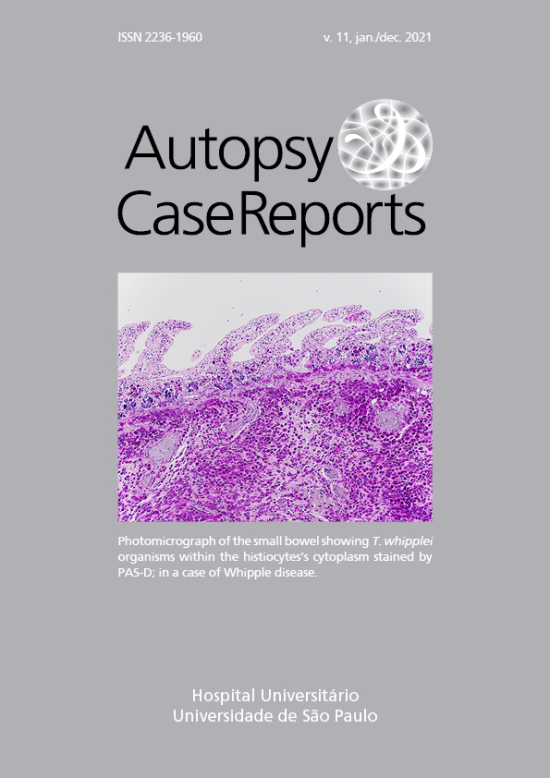De novo chronic lymphocytic leukemia/prolymphocytic leukemia or B-cell prolymphocytic leukemia? The importance of integrating clinico-morphological and immunophenotypic findings in distinguishing chronic lymphoproliferative diseases with circulating phase
DOI:
https://doi.org/10.4322/acr.2020.196Keywords:
Immunophenotyping, Leukemia, Lymphoid, Lymphadenopathy, Rare DiseasesAbstract
B-cell prolymphocytic leukemia (B-PLL) is an extremely rare disease, accounting for approximately 1% of the lymphocytic leukemias. B-PLL generally occurs in older people. It is characterized by the presence of more than 55% prolymphocytes in the peripheral blood (PB), no or minimal lymphadenopathy, massive splenomegaly, and very high white blood cell counts. The prognosis of B-PLL patients is generally poor, with a median survival of 3 years, although a subset of patients may show a prolonged survival. Herein, we report a case of a 70-year-old male with weakness, generalized lymphadenopathy, and moderate splenomegaly at the initial presentation. Hematologic examination revealed lymphocytic leukocytosis, favoring a chronic lymphoproliferative disorder (CLPD). The key to decoding the precise CLPD was a combination of the clinical profile, morphologic findings on the peripheral blood and the bone marrow, immunophenotypic analysis, and cytogenetic study. The best diagnosis proffered was a de novo chronic lymphocytic leukemia/prolymphocytic leukemia. There was no prior history of lymphoproliferative disorder or lymphocytic leukocytosis. Discriminating this entity from other lymphoproliferative disorders is crucial as the treatment and prognosis are varied compared to the other lymphoproliferative disorders. The diagnostic conundrum encountered and the incredible utility of ancillary studies in such a scenario are highlighted in this study.
Downloads
References
Collignon A, Wanquet A, Maitre E, Cornet E, Troussard X, Aurran-Schleinitz T. Prolymphocytic leukemia: new insights in diagnosis and in treatment. Curr Oncol Rep. 2017;19(4):29. http://dx.doi.org/10.1007/s11912-017-0581-x. PMid:28324286.
Campo E, Ghia P, Montserrat E, et al. Chronic lymphocytic leukemia/small lymphocytic lymphoma. In: Swerdlow SH, Campo E, Harris NL, et al. WHO classification of tumours of haematopoietic and lymphoid tissues. Lyon: IARC; 2017. p. 216-21.
Bennett JM, Catovsky D, Daniels MT, et al. Proposals for the classification of chronic (mature) B and T lymphoid leukemias. French-American-British (FAB) Cooperative Group. J Clin Pathol. 1989;42(6):567-84. http://dx.doi.org/10.1136/jcp.42.6.567. PMid:2738163.
Dearden C. How I treat prolymphocytic leukemia. Blood. 2012;120(3):538-51. http://dx.doi.org/10.1182/blood-2012-01-380139. PMid:22649104.
Ravandi F, O’Brien S. Chronic lymphoid leukemias other than chronic lymphocytic leukemia:diagnosis and treatment. Mayo Clin Proc. 2005;80(12):1660-74. http://dx.doi.org/10.4065/80.12.1660. PMid:16342661.
Galton DA, Goldman JM, Wiltshaw E, Catovsky D, Henry K, Goldenberg GJ. Prolymphocytic leukemia. Br J Haematol. 1974;27(1):7-23. http://dx.doi.org/10.1111/j.1365-2141.1974.tb06769.x. PMid:4137136.
Melo JV, Catovsky D, Galton DAG. The relationship between chronic lymphocytic leukaemia and prolymphocytic leukaemia. Clinical and laboratory features of 300 patients and characterization of an intermediate group. Br J Haematol. 1986;63(2):377-87. http://dx.doi.org/10.1111/j.1365-2141.1986.tb05563.x. PMid:3487341.
Merchant S, Schlette E, Sanger W, Lai R, Medeiros LJ. Mature B-cell leukemias with more than 55% prolymphocytes: report of 2 cases with Burkitt lymphoma-type chromosomal translocations involving c-myc. Arch Pathol Lab Med. 2003;127(3):305-9. PMid:12653573.
Del Giudice I, Osuji N, Dexter T, et al. B-cell prolymphocytic leukemia and chronic lymphocytic leukemia have distinctive gene expression signatures. Leukemia. 2009;23(11):2160-7. http://dx.doi.org/10.1038/leu.2009.137. PMid:19641528.
Franco V, Florena AM, Stella M, et al. Splenectomy influences bone marrow infiltration in patients with splenic marginal zone cell lymphoma with or without villous lymphocytes. Cancer. 2001;91(2):294-301. http://dx.doi.org/10.1002/1097-0142(20010115)91:2<294::AID-CNCR1001>3.0.CO;2-W. PMid:11180074.
Van der Velden VHJ, Hoogeveen PG, de Ridder D, et al. B-cell prolymphocytic leukemia: a specific subgroup of mantle cell lymphoma. Blood. 2014;124(3):412-9. http://dx.doi.org/10.1182/blood-2013-10-533869. PMid:24891323.
Campo E, Matutes E, Montserrat E, Harris NL, Stein H, Muller-Hermelink HK. B-cell prolymphocytic leukaemia. In: Swerdlow SH, Campo E, Harris NL, et al. WHO classification of tumours of haematopoietic and lymphoid tissues. Lyon: IARC; 2017. p. 222-23.
Bindra BS, Kaur H, Portillo S, Emiloju O, de de Jesus KG. B-cell prolymphocytic leukemia: case report and challenges on a diagnostic and therapeutic forefront. Cureus. 2019;11(9):e5629. http://dx.doi.org/10.7759/cureus.5629. PMid:31700732.
Cross M, Dearden CB. B and T cell prolymphocytic leukaemia. Best Pract Res Clin Haematol. 2019;32(3):217-28. http://dx.doi.org/10.1016/j.beha.2019.06.001. PMid:31585622.
Downloads
Published
Issue
Section
License
Copyright (c) 2021 Autopsy and Case Reports

This work is licensed under a Creative Commons Attribution 4.0 International License.
Copyright
Authors of articles published by Autopsy and Case Report retain the copyright of their work without restrictions, licensing it under the Creative Commons Attribution License - CC-BY, which allows articles to be re-used and re-distributed without restriction, as long as the original work is correctly cited.



